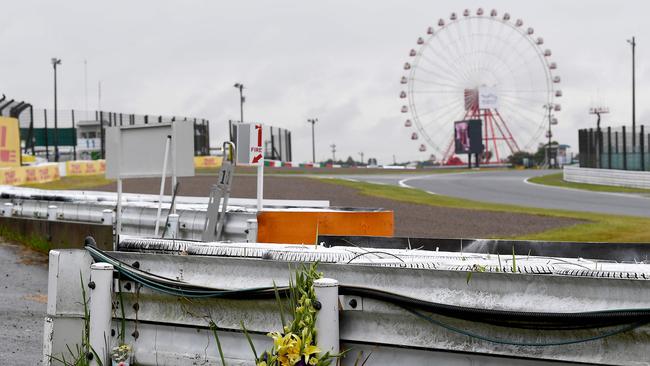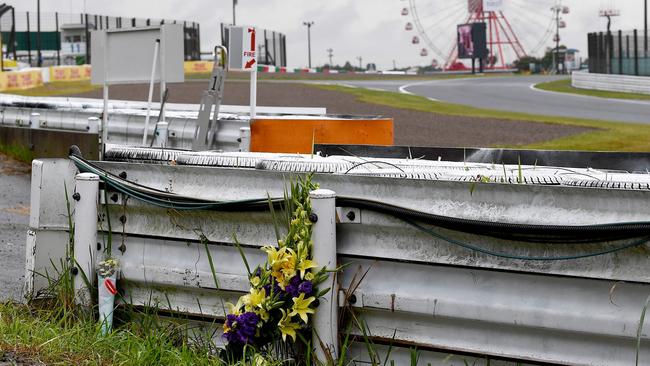Formula 1, Japan Grand Prix: Pierre Gasly penalty, similarities to Jules Bianchi crash, death
Eight years on from the death of star driver Jules Bianchi, and F1 has learnt nothing – with drivers, fans and experts furious over an outrageous safety breach.

F1
Don't miss out on the headlines from F1. Followed categories will be added to My News.
The FIA report into Jules Bianchi’s crash at the 2014 Japanese Grand Prix that later claimed his life bears striking similarity to the events which unfolded at Suzuka on Sunday that have left Formula 1 drivers and fans furious.
On that day, October 5 2014, heavy rain from Typhoon Phanfone made for treacherous racing conditions with water pooling across the track and spray from the cars significantly limiting visibility.
Bianchi lost control at turn seven and went flying off the track, crashing into a recovery crane that was attempting to move the wrecked car of Adrian Sutil who had come off at the same place a lap earlier.
Bianchi was placed into an induced coma and died nine months later.
The Accident Panel’s report into the incident, coming two months after the crash on December 3 2014, outlined 11 overarching conclusions – a number of which, read eight years later, make for difficult reading.

The panel concluded “Bianchi did not slow sufficiently to avoid losing control at the same point on the track as Sutil” and that, “if drivers adhere to the requirements of double yellow flags … then neither competitors nor officials should be put in immediate or physical danger.”
The report continues by outlining all the circumstances in which Bianchi was at fault for the crash, before finishing by stating: “It is imperative to prevent a car ever hitting the crane and/or the marshals working near it”.
Just four days removed from the eight-year anniversary of Bianchi’s crash, at the very same circuit and with heavy rain falling, a crane was deployed to recover Carlos Sainz’s Ferrari following a lap one crash in which his car aquaplaned from the track and into barricades.
One lap later, vision from Sainz’s on-board camera showed a race marshal standing on the track as cars drove past behind a safety car.
Pierre Gasly later told reporters he feared for his life after he drove within metres of the crane, which was parked inside the white lines of the track, at more than 200km/h, as he attempted to join the remainder of the field in safety car formation having started the race from the pit lane.

The FIA initially remained silent on the recovery vehicle controversy but was quick to issue a stewards notice to Gasly for speeding under red flag conditions.
The light indicating a red flag appeared on Gasly’s steering wheel only seconds before he came alongside the tractor.
Gasly claimed the speed at which he was travelling was irrelevant, given the on-track conditions meant he could have lost control no matter his pace.
He was later issued a 20-second race time penalty and two penalty points for the infringement.
Hours after the race had finished, the FIA released a statement that began in defence of the controversy as “normal practice” before declaring a review would be launched.
“While it is normal practice to recover cars under safety car and red flag conditions, due to the particular circumstances and also taking into account feedback from a number of drivers, the FIA has launched a thorough review of the events involving the deployment of recovery vehicles during the Japanese Grand Prix,” a spokesman said.

The FIA’s move to initially blame the driver’s speed and later defend the deployment of the recovery crane as standard operating procedure bore a striking similarity to the report into Bianchi’s crash eight years earlier.
After the race Sebastian Vettel, who was on-track at Suzuka in 2014, told Sky Sports the lessons learned from Bianchi’s crash were “probably not enough after what happened (on Sunday)”.
“There are a lot of things that led to this circumstance that we need to understand,” Vettel said.
“First, the entire grid leaves on the wrong tire which we are all to blame … we have an intermediate tire that is a lot faster than the extreme tire; the extreme tire is a tire for the (wet) conditions but it’s so slow you are pressured to go onto the next tire.

“We are not able to race when there is some water on the track because the water drainage is probably not good enough. We’ve known this for years. One thing leads to another and then we had a crash with Carlos going off.
“Visibility is close to none when you’re inside the car following with the spray and we’re lucky that nothing happened, but we need to understand and make sure it must not happen (again).
“Today we just got lucky.”
Charles Leclerc, the godson of Bianchi and who drives for Ferrari in his honour, labelled the incident as “simply not acceptable”.
“There was a safety car yes but a crane on track at that place where obviously there was a lot of water where people could lose control at any time, the visibility was incredibly bad, it could have ended very badly,” he told Sky Sports.
“In 2014 we know what happened so yeah, this should not have happened.”
Watch Every Practice, Qualifying & Race of the 2022 FIA Formula One World Championship™ Live on Kayo. New to Kayo? Start your free trial now >
More Coverage
Originally published as Formula 1, Japan Grand Prix: Pierre Gasly penalty, similarities to Jules Bianchi crash, death




